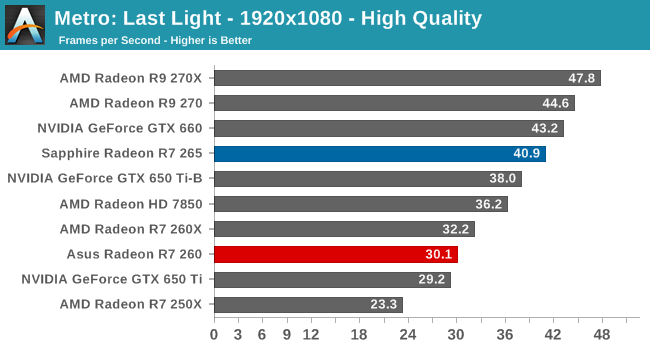The AMD Radeon R7 265 & R7 260 Review: Feat Sapphire & Asus
by Ryan Smith on February 13, 2014 8:00 AM ESTMetro: Last Light
As always, kicking off our look at performance is 4A Games’ latest entry in their Metro series of subterranean shooters, Metro: Last Light. The original Metro: 2033 was a graphically punishing game for its time and Metro: Last Light is in its own right too. On the other hand it scales well with resolution and quality settings, so it’s still playable on lower end hardware.


With AMD’s R7 260 series restructuring, NVIDIA’s closest competitor to the R7 265 and R7 260 for the moment is the GTX 650 Ti, with the GTX 660 also partially competing with the R7 265 from above. A win for AMD in this case is for the R7 260 to beat the GTX 650 Ti, and for the R7 265 to come within striking distance of the GTX 660.
To that end, both of AMD’s new cards have little trouble hitting their goals under Metro. At high quality settings the R7 265 is within 6% of the GTX 660 while the R7 260 edges out the GTX 650 Ti. Meanwhile at lower quality settings, where both cards should be far more playable than the 30-40fps rates we saw at high quality, both cards easily surpass NVIDIA’s closest competitors.










52 Comments
View All Comments
just4U - Thursday, February 13, 2014 - link
While you may be right... AMD/Ati does like throwing popular configurations into the mix.. The 265 reminds me a lot of the 4830 and while that card was fairly short lived it was a hot seller for them as it straddled two performance areas but came in at a nicer price point.jabber - Friday, February 14, 2014 - link
Indeed I swapped from being a longtime Nvidia user to AMD back in 2009 as I got fed up with Nvidia regurgitating the old 8800 chips three times in a row for the mid level.Stuff doesn't have to change radically performance wise but its nice to know new features are added and other things get revised and tweaked. A simple name change isn't enough really.
MrSpadge - Thursday, February 13, 2014 - link
I'm actually happy they're finally making use of that last digit in their 3-number scheme. From my point of view they could have ditched the X altogether and make the R9-270X an R9-275 (or whatever is appropriate). And speaking of R9: they could have given the R7 265 the rating R9 265 to more closely connect it with R9 270. Or just drop that prefix as well, if the numbers don't overlap anyway and the R9/7/3 is not related to features either!Speaking about the cards:
- boost clocks additional 25 MHz again? I have no idea why these are there. Make it 100+ MHz of leave it.
- 1.175 V for a mere 925 MHz? The chip should be able to do 1.0 GHz at ~1.0 V, maybe 1.10 V for guaranteed clocks
- same for R7 260 - that voltage is ridiculously high
Anyway, the cards themselves are fine (just like the 7000 series) and the coolers really fit them.
silverblue - Thursday, February 13, 2014 - link
The single GPU frame latency issue has been fixed for more than six months. I doubt it's going to become a problem again like with AMD's handling of 2D a while back.There are remarks concerning the availability of the R9 270 series and the inability for these parts to keep to their RRP, both of which may not be present if this was some sort of fanboy review.
Spuke - Thursday, February 13, 2014 - link
Has it been 6 months? I thought they recently fixed that problem.silverblue - Thursday, February 13, 2014 - link
It was fixed in Cat 13.8 Beta 1, dated 1st August.silverblue - Thursday, February 13, 2014 - link
My bad - that's when CrossFire had its first fix. Apparently, single-GPU was fixed beforehand, though I can't find which driver version it was.Solid State Brain - Thursday, February 13, 2014 - link
Anandtech: it would be interesting if you tested idle power consumption in multi monitor scenarios. I think you will find out some surprises.creed3020 - Thursday, February 13, 2014 - link
Excellent point!I had a friend with a 6950 and he was furious that his video card would never idle down in gpu/memory frequencies when he had a second monitor connected.
I personally have a 6850 and two 20" LCDs connected over DVI. I have not looked for the same behaviour but would not be surprised if it were the same.
Power efficiencies are out the window once the user chooses to go multi-monitor to be more productive.e
Solid State Brain - Thursday, February 13, 2014 - link
I have the same issue with my HD7770 to a lesser extent and my workaround for that is connecting my two secondary displays on the integrated Intel GPU. This saves a significant amount of power.